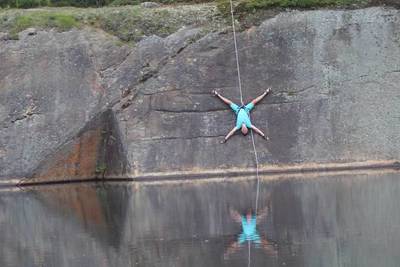Dance of Discovery: Cape Ann’s Quarry Dances

Quarry Dance 5, 2016. All images courtesy Lisa Hahn. Photo: Leslie Bartlett
By Olivia J. Kiers
Tucked away in Rockport, MA, on a former dairy farm, Windhover Performing Arts Center’s studios, cabins, garden and theater are far from the noise and grit of the city, yet it is a magnate for talent coming from urban areas. Among the many performing artists and dancers who appreciate Windhover’s seclusion and the natural charm of Cape Ann is the Brooklyn, NY-based Dusan Tynek Dance Theater. Every summer since 2012, Dusan Tynek—a modern dance choreographer known for his inventive use of space—and his dancers have performed a summer “Quarry Dance” at one of Cape Ann’s renowned quarries, facilitated by Windhover. Now, on the eve of Windhover’s 50th anniversary in 2018, executive director Lisa Hahn explains how these performances first began, then grew to be a beloved part of the Windhover tradition.
Art New England: How did the first Quarry Dance come about?
Lisa Hahn: The credit goes to my mom [Ina Hahn]. Her feeling was that art and nature should be more combined, and that often the natural amphitheater of a quarry space is the perfect proscenium for dance. She wanted to celebrate the natural beauties of Cape Ann, while engaging the arts to elevate and highlight those resources.
The two of us have always searched out these quarries on Cape Ann. We’d take long walks through the woods. There are 40 of them, and my mom and I know where they all are. Now, I am really just caring for her vision; she passed away last year.
ANE: When the first Quarry Dance occurred, did you or your mother foresee it becoming an annual event?
LH: No, we didn’t! Like any great art, you just forge ahead with a vision, and the strength of the vision carries its own set of demands. The buzz about the first Quarry Dance was just so extraordinary… Dusan Tynek Dance Theater became part of the fabric of the piece because they loved doing the first one so much.

Dusan Tynek in Quarry Dance 3, 2014.
ANE: Where are some of the challenges of performing in these spaces?
LH: The problem with the first one was that we were not allowed to swim in the water, because it was a reservoir. Another part of the company’s desire to continue the Quarry Dances initially came from wanting a chance to use the water. The last four have been private quarries where swimming was allowed because I worked hard to get the permission from the quarry owners.
Unfortunately, this year we cannot use the water again, but the dance area around Flat Ledge Quarry in Rockport is flat, wide and beautiful, with cliffs… Using the quarry as a backdrop like we did in the first dance will be fantastic.
ANE: What is the audience experience like?
LH: Last year, there were two spots for chairs, where the audience could sit and see everything. Some of it was far away, and other parts were close up. However, if they wanted to follow the dancers—and the company loves that idea—they could. Many audience members just followed the dancers around then perimeter of the quarry. At each section where the dancers stopped, the audience would sit on rocks nearby and watch.
This year, there is one big, open section where I think the audience will remain for most of the performance… It all depends on what the choreographer envisions.

Quarry Dance 5, 2016. Photo: Leslie Bartlett
ANE: How much of the choreography and rehearsal occurs on site versus in the studio?
LH: The choreographer arrives one week in advance of the performances, and they start rehearsing at the quarry from the get-go. The whole piece is created in one week as they walk and hike the cliffs, finding out what is available. Sometimes they might use fragments from other pieces they are working on, and incorporate that into the dance (otherwise, it is overwhelming to create an hour-long dance in five days). But, generally, they create really quickly.
ANE: Are there themes to the different Quarry Dances?
LH: There are messages that we subtly want to send and encourage. We’re in a world of diminishing resources, where developers are coming and destroying national treasures if they are not first landmarked as parks. The places that we have left need to be appreciated.
ANE: Any parting thoughts?
LH: Just that a sense of exploration is very rare in this world, compared to the old days. Maybe Antarctica is that place now, for some. But in your own hometown? The Quarry Dances provide that for a lot of people. And a lot tell me they are encouraged to do more—like join a local hiking club—after attending one. I think that’s an important byproduct of what we are doing.
———-
Quarry Dance 6 performances takes place select mornings, afternoons and evenings at Flat Ledge Quarry (access via Granite Pier at 16 Wharf Road, Rockport, MA), July 28–30. Please see Windhover website for times. All performances are free, open to the public, and weather-dependent.
